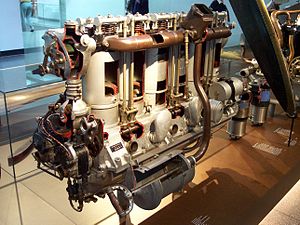Maybach Mb.IVa
| Mb.IVa | |
|---|---|
 |
|
| Type | 6-cyl water-cooled in-line piston engine |
| National origin | Germany |
| Manufacturer | Maybach-Motorenbau GmbH |
| Designed by | Karl Maybach |
| Major applications | Zeppelin airships (LZ 105 to 114) |
| Produced | 1916 - 1918 |
The Maybach Mb.IVa (written in German sources as Mb IVa, without a dot) was a six-cylinder, water-cooled, inline aircraft and airship engine developed in Germany during World War I by Maybach-Motorenbau GmbH, a subsidiary of Zeppelin. It was one of the world's first series-produced engines designed specifically for high-altitude use. It was quite different engine design than the previous Maybach Mb.IV, not just a simple modification.
Like all engines of that time, the previous Maybach design, the Mb IV, lost at high altitude as much as half of the nominal power of 240 horsepower. The new Maybach Mb IVa of 1916 was the first engine designed to overcome this limitation. It did not use a supercharger, but a much more primitive solution. The engine had purposely "oversized" cylinders, and a significantly higher 6.08:1 compression ratio. It was tested on Wendelstein (mountain) at an altitude of 1800 m and rated there at 245 hp. This would theoretically correspond to rating of about 300 hp at sea level; however, the engine was not designed to withstand such power - it needed to be carefully throttled down at low altitude, so it would not exceed the safe level of 245 hp. It had three carburettor settings, to be changed during the flight depending on the altitude.
The engine has been falsely designated as 260 hp (190 kW) at sea level, so it would not appear inferior to the engines it replaced.
The earlier Maybach's engines were:
The power ratings for these older engines are at sea level, unlike the rating of the Mb IVa.
Data from Kleinheins.
...
Wikipedia
